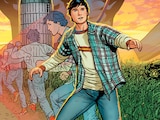What is DC Pride really about? Each year represents a milestone—the latest step in a long journey to be openly yourself. We link sexual identity to Pride because for so long, in so many repressive cultures, it wasn’t considered proper or prudent to express ourselves in ways that fell outside what was considered the norm. In comics, we’ve come a long way from the days of the Comics Code Authority governing what kinds of love are acceptable and which parts of ourselves can be seen on a page. And that’s good because it’s not always enough to say, “I love you.” It’s not always enough to share your life. It’s not even enough to raise a family together. Sometimes, true representation can only happen with a kiss. These are five of our most noteworthy.


Gotham Central, “Half a Life”
2003’s “Half a Life” represents what might be Greg Rucka’s most important work with DC Comics. A biting, necessary account of the effects of existing as queer in an environment openly hostile to queerness, be that your workplace, your family, or simply America. Renee Montoya’s first open kiss in comics was exposed to the world without her consent, as an act of violence. The fact that a display of affection could even be used that way at all was an open indictment of the perverse way a restrictive society views the concept of love. It was in many ways an opening dialogue in the conversation that still continues today with DC Pride.


Wonder Woman: The True Amazon
A great deal has been written over the past 80 years about the inherent queerness of Wonder Woman and the Amazons, from its very first issues by William Marston. Always coded, rarely acknowledged, and frequently, even in those circumstances, under the couching of “plausible deniability.” Coded language. Asexual, physical affection. “Why can’t two women just be friends?” All symptoms of an inherent discomfort with homosexual affection that has pervaded popular media for far too long.
Wonder Woman has had lovers before, as alluded to in Greg Rucka’s Wonder Woman: Year One. But there, too, it was always an off-panel suggestion. Jill Thompson’s 2016 original graphic novel Wonder Woman: The True Amazon literally concludes on an image of Diana kissing the face of Alethea, an Amazonian stablewoman whose evasive affection she seeks throughout the story—a desire which arguably leads to Alethea’s death. And sure, there’s a non-queer way to read this story and this culminating scene, if you really strain your neck. But if you find yourself doing that, there are really some questions you need to start asking yourself.


Harley Quinn, “There’s No Place to Go But Down”
We’ve spent a good deal of our DC Pride coverage over the years exhaustively charting the arc of Harley Quinn and Poison Ivy’s relationship, attempting to pinpoint the exact moment the levee broke on their depiction as “ambiguous gal pals” to “canonical girlfriends.” After examining the data, it’s almost inarguable that the inflection point was the culmination of their romance on television in season two of the Harley Quinn animated series. An appropriate venue, to be sure—it was on TV that Harley was born, and where Harley and Ivy first met. The comics got a lot less gun shy about opening their romantic connection to each other from there and that’s been their story ever since.


Superman: Son of Kal-El, “Who’s Got You?”
In a period defined by expanding what the concept of Superman can represent, Clark’s son Jon Kent was leading the Superman title in 2021 and exploring if a life wholly dedicated to service for others might possibly have space for love and romance. It was a major headline making moment when the active Superman at the time started up a relationship with a new boyfriend. But what this kiss from Superman: Son of Kal-El #5 represents is an openness to love and to being loved, wherever it comes for you. After all, to have Pride is to place value in yourself.


Tim Drake: Robin
Sometimes, you’re the last to know who you really are. While fans of the character have long suspected that something wasn’t 100% straight with Batman’s most dedicated Robin, the personal journey for Tim Drake was nevertheless a pretty long one. Even after writer Meghan Fitzmartin began exploring the sexuality of the long self-questioning Boy Wonder in 2021’s Batman: Urban Legends, Tim himself would exist in a state of uncertainty about it for three more years. What does it mean that he thinks he might maybe want to date a boy? Where does he fall under the queer umbrella?
The reality is that might not matter as much as you think it does. Nailing down exactly what letter in the QUILTBAG applies to you is not a prerequisite of being welcome at Pride. If you feel like your love or identity falls outside of historically mandated heteronormativity, Pride is for you. It’s here, in this kiss with his boyfriend Bernard from 2023’s Tim Drake: Robin #6, that Tim gains enough footing to stand for himself. And after generations of whispered speculation, we finally had an undeniably queer Robin. Take that, Wertham.
Alex Jaffe is the author of our monthly "Ask the Question" column and writes about TV, movies, comics and superhero history for DC.com. Follow him on Bluesky at @AlexJaffe and find him in the DC Official Discord server as HubCityQuestion.
NOTE: The views and opinions expressed in this feature are solely those of Alex Jaffe and do not necessarily reflect those of DC or Warner Bros. Discovery, nor should they be read as confirmation or denial of future DC plans.




















